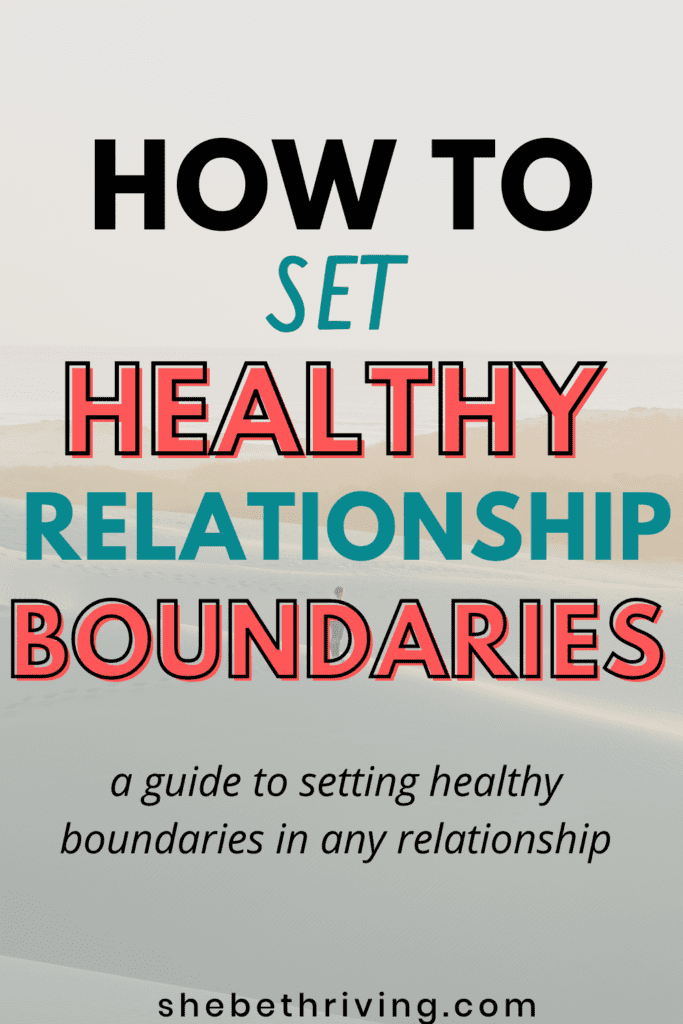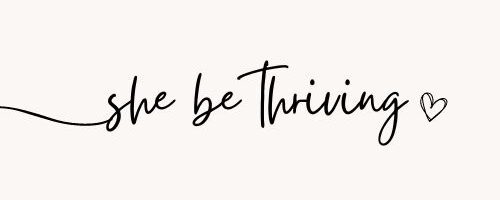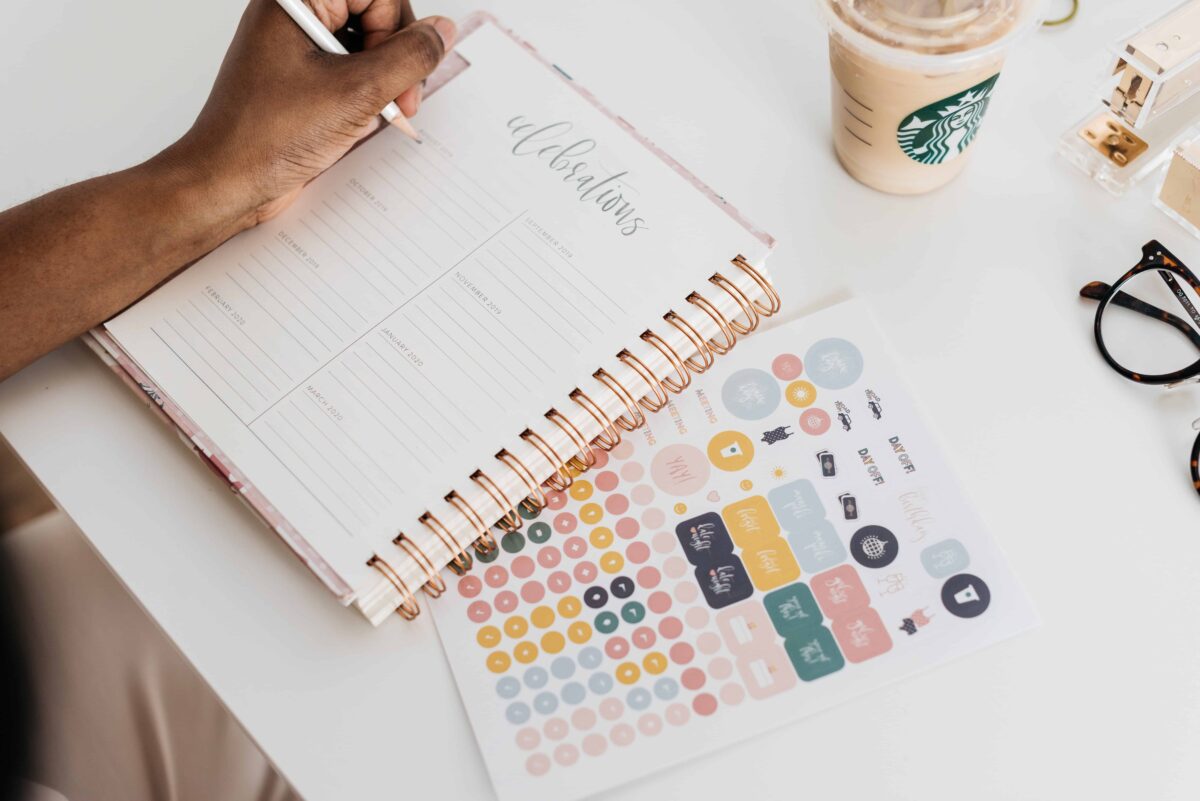Setting Healthy Relationship Boundaries: 5 Powerful Tips
The ultimate guide to setting healthy boundaries in your relationships
“I have a really hard time saying ‘no’ to others. I care too much about what he/she thinks. I’m afraid of disappointing my partner. It’s difficult for me to express my desires and needs in my relationships.”
Do any of these thoughts resonate with you? As a recovering people pleaser, I struggled with these thoughts daily. In the past, I would agree to things I didn’t want to do, go to places I didn’t enjoy going to, and spend time with people I didn’t really enjoy being around.
I didn’t realize the importance of setting healthy relationship boundaries.
My fear of rejection and disappointing others became so deeply entrenched when I started dating. I felt like dating, while struggling with social anxiety, really allowed me to see how much I really just desired to be loved and accepted by someone else.
As we continue to grow and change as individuals, our boundaries continue to change as well. Some of our boundaries won’t always be rigid and fixed. Sometimes, we need to adjust them accordingly. At the same time, it’s important to set healthy boundaries in our lives so that we can take good care of ourselves.
This article will provide helpful tips and strategies on how to specifically set healthy boundaries in your relationships.

“This post contains affiliate links, which means I may receive a small commission, at no extra cost to you, if you make a purchase using this link. Please see my disclosure for more details.”
What are healthy relationship boundaries?
Boundaries are needs that are established to help you feel cared for and safe in your relationships. Establishing healthy boundaries allows you to feel safe and demonstrates to others how they should treat you. Later in this article, I’ll give examples of what healthy boundaries look like in 3 most common types of relationships: family, your partner, and friends.
But how do you know if you struggle with boundaries? Here are a list of questions to ask yourself to know if you might have boundary issues.
- Do you have a difficult time saying ‘no’ to others because you’re afraid of disappointing them?
- Do you avoid phone calls and interactions with people who might ask for something?
- Do you tend to feel resentment when people ask for your help but do it anyway?
- Do you fear being mean or rude if you say ‘no’ to someone?
- Do you tend to prioritize others over yourself?
- Do you feel like there’s always an extreme in your relationships? Either it’s amazing or awful and there’s no in-between?
- Do you feel like you’re always the one giving and rarely receiving from others?
If you found yourself saying ‘yes’ to several of these statements, chances are you may struggle with establishing healthy boundaries. Many of us aren’t aware that we have boundary issues until we notice how a lack of boundaries affects our mental health and ability to function.
3 types of relationship boundaries (you need to know)
There are three types of boundaries: porous, rigid, and healthy boundaries.
Porous boundaries are poor, weak boundaries that may lead to feelings of anxiety, fear, an anxious attachment style, and depression.
Porous boundaries may look like:
- People-pleasing
- Having difficulty saying ‘no’
- A huge fear of rejection and judgment
- Codependency
- Oversharing information
- Anxious attachment style
An example of a porous boundary:
- Your friend shows up to your house uninvited and wants to hang out. You, however, have a lot of work to catch up on or you may just not even feel like socializing. But you don’t want to come off as rude, so you resentfully hang out with your friend until he/she leaves.
Rigid boundaries are extreme, unhealthy rules that are created to build distance and preserve yourself from getting hurt by others.
Rigid boundaries may look like:
- Keeping to yourself and never sharing
- Avoiding vulnerability
- Avoids intimacy
- May come off as detached in romantic relationships
- Avoidant attachment style
- Have high expectations of others
An example of a rigid boundary:
- You have a rule that you’ll never spend more than 2 hours with someone even if you’re having a fun time with them. You have a belief that you have more important things to do, so you limit the time you spend with them.
Healthy boundaries involve an awareness of your values, mental capacity, and needs and expectations. Healthy boundaries are verbalized and clearly communicated with others.
Healthy boundaries may look like:
- Knowing what you will and will not tolerate
- Identifying your values
- Sharing appropriately with others
- Can say ‘no’ comfortably
- Does not take rejection personally
- Clearly communicating your needs with others
- Secure attachment style
An example of a healthy boundary:
- Your friend is moving into her apartment and asks for your help, but you have plans. Rather than agreeing to help, you tell her, “I can’t help you this weekend since I have plans. I hope the moving process goes smoothly, though!”
If you would like to know more about different attachment styles, I highly recommend reading the book, Attached, which discusses how each attachment style can affect relationship boundaries. The book also helps you identify which attachment style you have and how you can have a more secure relationship with your partner.
Now, let’s jump into how you can get started to set healthy relationship boundaries in your life.

How to get started with setting healthy relationship boundaries
1. Identify your boundaries that already exist (or lacking of)
First, it’s important to identify what boundaries you currently have and boundaries you need to start implementing in your life. These boundaries may be porous, rigid, or healthy. Refer back to the signs of what each boundary may look like and see if you can identify yourself with them.
Create a list of your boundaries that already exist. Then, create another list of healthy boundaries you want to implement. Remember not to judge yourself while doing this. Simply acknowledge and take note of what you’re writing down.
2. Know your values
After you’ve identified your list of existing and desired boundaries, it’s essential to understand your values. This may take a bit of deeper thought work. If you’ve never really taken time to discover your values/beliefs, take this free personal values assessment.
When you know your values, it’s so much easier to know what your expectations and needs are. Your values will indicate what you will and will not tolerate from others.
3. Write down 1-3 boundaries for your relationships
Three common areas in relationships involve your friends, romantic relationships, and family. Since you may spend the most time with these groups of people, it’s important to set healthy boundaries with each one.
If you’ve noticed a lack of boundary with your close friends, what is one boundary you would like to have? Would you prefer that they stopped interrupting you while you’re in the middle of talking?
If your mother tends to gossip about other people, what if you set a boundary by telling her you feel uncomfortable talking about other people?
If your partner makes you initiate plans for dates most of the time, which you’d prefer if there was more balance, what if you told him you feel underappreciated when he makes you plan most dates? Let him know how you feel and tell him that you would like him to put in more effort in planning.
4. You are not responsible for the other person’s reaction
You can only control how you respond. This is so important to remember, friend! You are not responsible at all for how your partner, your mom or dad, and friend respond.
A big reason why people don’t communicate their boundaries is because of the fear of disappointing our loved ones. We’re afraid of their reaction. Maybe they’ll get upset, angry, sad, or even distance themselves from us.
However, if you’ve clearly communicated your boundary in a non-accusatory way (which I’ll show you how – so keep reading), then how they respond is beyond your control.
What you can control is how you communicate and respond. You are not a bad person for wanting to have healthy boundaries. You are brave and admirable for choosing to take care of yourself. Please remember that!

Tips for success in setting healthy relationship boundaries
1. Accept yourself as you are.
You are allowed to take up space in this world. You are allowed to have imperfections and flaws. When you allow yourself to own your quirks, that people-pleasing part of you that wants to conform to other people won’t have any power over you.
Here are practical ways to accept yourself as you are:
- Write down a list of things you like about yourself (your quirks included)
- Practice self-compassion
- Talk to yourself the way you would to a best friend
- When you feel negative about yourself, validate your feelings by saying, “It’s okay to feel this way.” Oftentimes, we try to force ourselves to feel better, but sometimes what we really need in the moment is to feel validated and seen.
2. Consider your own needs before agreeing
Take a second to pause before agreeing to a request from someone. Make this a practice in your life, especially if you have a tendency to say ‘yes’ immediately. If this request is in-person, it may even be harder to say ‘no.’
This is how it could look like in real life situation:
Your friend asks you to go out drinking at a bar even though you don’t feel comfortable doing so. She says that she’s been having a rough day and wants to grab drinks.
If this is in-person, take a moment to pause rather than quickly saying ‘yes, of course we grab drinks.’ If you don’t feel comfortable drinking, but would rather do something else, tell your friend, “I won’t drink and don’t feel comfortable being at a bar. I still do want to hang out, so can we do something else?”
This boundary shows that you’ve clearly communicated what you don’t want to do and that you still want to hang out with your friend.
3. Use I-statements to assert your needs
The best boundary statements start with communicating your needs with “I” statements. When you use I-statements, you’re acknowledging your emotions. At the same time, it will feel less of a personal attack to the other person.
Here are examples of “I want” statements:
- I want you to stop assuming how I feel and ask me instead.
- I want you to stop talking about the future so often so that we can be more present together.
- I want you to stop gossiping about my friend because it makes me feel uncomfortable.
Here are examples of “I need” statements:
- I need you to let me know a few days prior when you’re available so I can figure out my schedule.
- I need you to text me if you’re coming home for dinner tonight.
Here are examples of “I expect” statements:
- I expect you to get here on time for my party.
- I expect you to arrive at the party sober.
Using “I want,” “I need,” or “I expect” statements establishes your boundaries and helps you communicate them clearly to others.
4. Address issues and misunderstandings while they are still small
It’s important to deal with issues and misunderstandings while they are still small rather than having them build up. When we tend to brush off seemingly small annoyances and conflicts, they can eventually result into bigger problems later in your relationships.
Here are some helpful tips to address these issues in your relationships when you notice them:
- Use I-statements (refer back to tip #3) when addressing how their behavior makes you feel
- Be open-minded to hearing them before making your own judgment
- Let them know that you still value your relationship
- Don’t bring up the past
- Remember that you are responsible for your emotions and cannot control theirs
- If you’re at fault, own up to your mistakes and apologize if needed
5. Follow through with your boundaries
Healthy boundaries are consistent and clearly communicated with others. This means that you need to follow through with your boundaries if they are violated.
For example, let’s say you’ve clearly stated to a friend that she needs to let you know a few days prior before showing up to your house unannounced. One day, she decides to show up to your place, violating your boundary.
You will have to tell her your boundary again. You could say, “I feel disrespected when you show up to my house without letting me know. I need to know a few days prior because I have things I need to do as well.” You can either tell her to politely leave because you have things you need to do or you can tell her when you’re available next so that she can come over.
The most important takeaway is to keep re-stating your boundaries if they are violated. You need to be firm with your boundaries.
People might guilt-trip, test, or question your boundaries, but do not sway for the sake of others. Stand your ground and confront those who violate your boundaries.

Frequently Asked Questions
The last thing you need to know about setting healthy relationship boundaries
Boundaries are super duper important to set in your life. Maybe you’ve never really thought about your personal boundaries, and that’s why, I’d encourage you to reflect on what boundaries you want to create in your life.
Remember, clear communication is essential for setting healthy relationship boundaries.
To recap, here are the 5 tips to set healthy relationship boundaries:
- Accept yourself as you are – all your imperfections and flaws
- Consider your own needs before agreeing
- Use I-statements to assert your needs
- Address issues and misunderstandings while they are still small
- Follow through with your boundaries
I hope you found this post helpful! If you did, I’d love to know what kind of boundary you want to set or have created in your life! Comment down below to let me know 🙂

Related articles about setting healthy boundaries
How to Overcome Your Deep Fear of Rejection
The Ultimate Guide To Making and Keeping Friends As An Adult
Feeling Lonely After A Breakup? Here’s How To Deal With It.







